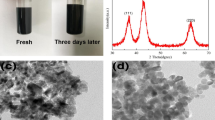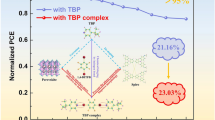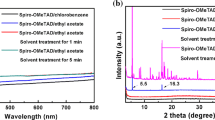Abstract
2,2′,7,7′-tetrakis-(N,N-di-4-methoxyphenylamino)-9,9′-spirobifluorene (spiro-OMeTAD), as the most common used hole transport material (HTM), plays a significant role in the normal structured (n-i-p) high-efficiency perovskite solar cells (PSCs). In general, it is prepared by a halogen solvent (chlorobenzene, CBZ) and needs an ion dopant (lithium bis (trifluoromethanesulfonyl)imide, Li-TFSI) to improve its conductivity and hole mobility. However, such a halogen solvent is not environmentally friendly and the widely used Li-TFSI dopant would affect the stability of PSCs. Herein, we develop a non-halogen solvent—tetrahydrofuran (THF)-prepared spiro-OMeTAD solution with a new p-type dopant, potassium bis(fluorosulfonyl)imide (K-FSI), to apply into PSCs. By this strategy, high-hole-mobility spiro-OMeTAD film is achieved. Meanwhile, the potassium ions introduced by diffusion into perovskite surface passivate the interfacial defects. Therefore, a hysteresis-free champion PSC with an efficiency of 21.02% is obtained, along with significantly improved stability against illumination and ambient conditions. This work provides a new strategy for HTMs toward hysteresis-free high-efficiency and stable PSCs by substituting dopants.
摘要
作为最常用的空穴传输材料, spiro-OMeTAD在正式结构的高效钙钛矿太阳能电池(PSCs)中起着重要作用. 一般来说, spiro-OMeTAD是基于卤素溶剂氯苯制备的, 并且需要离子型添加剂(Li-TFSI)来提高其导电性和空穴迁移率. 然而, 这种卤素溶剂并不环保, 而且普遍使用的Li-TFSI会影响PSCs的稳定性. 在此, 我们针对spiro-OMeTAD开发出一种新型的p型添加剂(双氟磺酰亚胺钾, K-FSI)并且以无卤素溶剂四氢呋喃作溶剂将其应用于PSCs器件. 通过该方法制备的spiro-OMeTAD薄膜具有更高的空穴迁移率、 载流子浓度以及导电性. 同时, 由空穴传输层引入的钾离子可以扩散到钙钛矿表面使界面缺陷得到钝化. 因此, 基于K-spiro薄膜的钙钛矿太阳能电池获得了21.02%的最高光电转化效率并且无迟滞现象存在, 而且电池器件的光照稳定性和环境稳定性显著提高. 这项工作为通过替换空穴传输材料的添加剂实现无迟滞、 高效稳定的PSCs提供了新的策略.
Similar content being viewed by others
References
Park NG. Perovskite solar cell: Research direction for next 10 years. ACS Energy Lett, 2019, 4: 2983–2985
Kojima A, Teshima K, Shirai Y, et al. Organometal halide perovskites as visible-light sensitizers for photovoltaic cells. J Am Chem Soc, 2009, 131: 6050–6051
Green MA, Ho-Baillie A, Snaith HJ. The emergence of perovskite solar cells. Nat Photon, 2014, 8: 506–514
Xing G, Mathews N, Sun S, et al. Long-range balanced electron-and hole-transport lengths in organic-inorganic CH3NH3PbI3. Science, 2013, 342: 344–347
Stranks SD, Eperon GE, Grancini G, et al. Electron-hole diffusion lengths exceeding 1 micrometer in an organometal trihalide perovskite absorber. Science, 2013, 342: 341–344
Jiang Q, Zhao Y, Zhang X, et al. Surface passivation of perovskite film for efficient solar cells. Nat Photonics, 2019, 13: 460–466
Saparov B, Mitzi DB. Organic-inorganic perovskites: Structural versatility for functional materials design. Chem Rev, 2016, 116: 4558–4596
Shao JY, Yu B, Wang YD, et al. In-situ electropolymerized poly-amines as dopant-free hole-transporting materials for efficient and stable inverted perovskite solar cells. ACS Appl Energy Mater, 2020, 3: 5058–5066
Zhang L, Wu J, Li D, et al. Ladder-like conjugated polymers used as hole-transporting materials for high-efficiency perovskite solar cells. J Mater Chem A, 2019, 7: 14473–14477
Li D, Shao JY, Li Y, et al. New hole transporting materials for planar perovskite solar cells. Chem Commun, 2018, 54: 1651–1654
Burschka J, Dualeh A, Kessler F, et al. Tris(2-(1H-pyrazol-1-yl) pyridine)cobalt(III) as p-type dopant for organic semiconductors and its application in highly efficient solid-state dye-sensitized solar cells. J Am Chem Soc, 2011, 133: 18042–18045
Abate A, Leijtens T, Pathak S, et al. Lithium salts as “redox active” p-type dopants for organic semiconductors and their impact in solid-state dye-sensitized solar cells. Phys Chem Chem Phys, 2013, 15: 2572–2579
Habisreutinger SN, Noel NK, Snaith HJ, et al. Investigating the role of 4-tert butylpyridine in perovskite solar cells. Adv Energy Mater, 2017, 7: 1601079
Wang S, Sina M, Parikh P, et al. Role of 4-tert-butylpyridine as a hole transport layer morphological controller in perovskite solar cells. Nano Lett, 2016, 16: 5594–5600
Jena AK, Ikegami M, Miyasaka T. Severe morphological deformation of spiro-OMeTAD in (CH3NH3)PbI3 solar cells at high temperature. ACS Energy Lett, 2017, 2: 1760–1761
Liu Y, Hu Y, Zhang X, et al. Inhibited aggregation of lithium salt in spiro-OMeTAD toward highly efficient perovskite solar cells. Nano Energy, 2020, 70: 104483
Hawash Z, Ono LK, Raga SR, et al. Air-exposure induced dopant redistribution and energy level shifts in spin-coated spiro-MEo-TAD films. Chem Mater, 2015, 27: 562–569
Wang S, Huang Z, Wang X, et al. Unveiling the role of tBP-LiTFSI complexes in perovskite solar cells. J Am Chem Soc, 2018, 140: 16720–16730
Seo JY, Kim HS, Akin S, et al. Novel p-dopant toward highly efficient and stable perovskite solar cells. Energy Environ Sci, 2018, 11: 2985–2992
Li M, Wang ZK, Yang YG, et al. Copper salts doped spiro-ometad for high-performance perovskite solar cells. Adv Energy Mater, 2016, 6: 1601156
Pham ND, Shang J, Yang Y, et al. Alkaline-earth bis(trifluoromethanesulfonimide) additives for efficient and stable perovskite solar cells. Nano Energy, 2020, 69: 104412
Zhang J, Zhang T, Jiang L, et al. 4-tert-Butylpyridine free hole transport materials for efficient perovskite solar cells: A new strategy to enhance the environmental and thermal stability. ACS Energy Lett, 2018, 3: 1677–1682
Caliò L, Salado M, Kazim S, et al. A generic route of hydrophobic doping in hole transporting material to increase longevity of perovskite solar cells. Joule, 2018, 2: 1800–1815
Bu T, Liu X, Zhou Y, et al. A novel quadruple-cation absorber for universal hysteresis elimination for high efficiency and stable perovskite solar cells. Energy Environ Sci, 2017, 10: 2509–2515
Djellab H, Armand M, Delabouglise D. Stabilization of the conductivity of poly(3-methylthiophene) by triflimide anions. Synth Met, 1995, 74: 223–226
Shi D, Adinolfi V, Comin R, et al. Low trap-state density and long carrier diffusion in organolead trihalide perovskite single crystals. Science, 2015, 347: 519–522
Kang DH, Park NG. On the current-voltage hysteresis in perovskite solar cells: Dependence on perovskite composition and methods to remove hysteresis. Adv Mater, 2019, 31: 1805214
Li Z, Xiao C, Yang Y, et al. Extrinsic ion migration in perovskite solar cells. Energy Environ Sci, 2017, 10: 1234–1242
Yu H, Lu H, Xie F, et al. Native defect-induced hysteresis behavior in organolead iodide perovskite solar cells. Adv Funct Mater, 2016, 26: 1411–1419
Jiang LL, Wang ZK, Li M, et al. Flower-like MoS2 nanocrystals: a powerful sorbent of Li+ in the Spiro-OMeTAD layer for highly efficient and stable perovskite solar cells. J Mater Chem A, 2019, 7: 3655–3663
Burschka J, Kessler F, Nazeeruddin MK, et al. Co(iii) complexes as p-dopants in solid-state dye-sensitized solar cells. Chem Mater, 2013, 25: 2986–2990
Shen Y, Shen K-, Li Y-, et al. Interfacial potassium-guided grain growth for efficient deep-blue perovskite light-emitting diodes. Adv Funct Mater, 2021, 31: 2006736
Abdi-Jalebi M, Andaji-Garmaroudi Z, Cacovich S, et al. Maximizing and stabilizing luminescence from halide perovskites with potassium passivation. Nature, 2018, 555: 497–501
Zheng F, Chen W, Bu T, et al. Triggering the passivation effect of potassium doping in mixed-cation mixed-halide perovskite by light illumination. Adv Energy Mater, 2019, 9: 1901016
Bu T, Li J, Zheng F, et al. Universal passivation strategy to slot-die printed SnO2 for hysteresis-free efficient flexible perovskite solar module. Nat Commun, 2018, 9: 4609
Wetzelaer GJAH, Scheepers M, Sempere AM, et al. Trap-assisted non-radiative recombination in organic-inorganic perovskite solar cells. Adv Mater, 2015, 27: 1837–1841
Yang M, Guo R, Kadel K, et al. Improved charge transport of Nb-doped TiO2 nanorods in methylammonium lead iodide bromide perovskite solar cells. J Mater Chem A, 2014, 2: 19616–19622
Pascoe AR, Duffy NW, Scully AD, et al. Insights into planar CH3NH3PbI3 perovskite solar cells using impedance spectroscopy. J Phys Chem C, 2015, 119: 4444–4453
Bang SM, Shin SS, Jeon NJ, et al. Defect-tolerant sodium-based dopant in charge transport layers for highly efficient and stable perovskite solar cells. ACS Energy Lett, 2020, 5: 1198–1205
Xu B, Huang J, Ågren H, et al. AgTFSI as p-Type dopant for efficient and stable solid-state dye-sensitized and perovskite solar cells. ChemSusChem, 2014, 7: 3252–3256
Acknowledgements
This work was financially supported by the National Key Research and Development Plan (2019YFE0107200 and 2017YFE0131900), the National Natural Science Foundation of China (21875178 and 91963209), and Foshan Xianhu Laboratory of the Advanced Energy Science and Technology Guangdong Laboratory (XHD2020-001 and XHT2020-005). The Analytical and Testing Centre of Wuhan University of Technology and Hubei Key Laboratory of Low Dimensional Optoelectronic Material and Devices, Hubei University of Arts and Science is acknowledged for the XPS, XRD and SEM characterizations.
Author information
Authors and Affiliations
Contributions
Huang F and Bu T proposed and supervised the project. Lin Z conducted most of the experiments and analyzed the data as well as wrote the manuscript. Li J contributed to the experimental scheme and materials selection. Li H and Pan J performed the PL measurement. Mo Y and Wang C performed the stability test. Zhang XL, Zhong J, and Cheng YB revised the manuscript. All the authors contributed to the general discussion.
Corresponding authors
Additional information
Zhipeng Lin received his BS degree from Wuhan University of Technology (WUT) in 2019. He is currently a master degree candidate at Wuhan University of Technology. His current research interest is focused on the field of perovskite solar cells.
Tongle Bu received his PhD from WUT in 2019. He joined Okinawa Institute of Science and Technology Graduate University (OIST) as a postdoctoral fellow in 2020. He is currently working on the scalable printing of efficient and stable perovskite solar cells and modules.
Fuzhi Huang received his PhD in chemistry (2009) from The University of Melbourne, Australia. Currently, he is a full professor at the State Key Lab of Advanced Technology for Materials Synthesis and Processing, WUT. His research interest is developing new materials and techniques for high-efficiency organic-inorganic hybrid perovskite solar cells.
Conflict of interest
The authors declare that they have no conflict of interest.
Supplementary Information
Rights and permissions
About this article
Cite this article
Lin, Z., Li, J., Li, H. et al. A novel dopant for spiro-OMeTAD towards efficient and stable perovskite solar cells. Sci. China Mater. 64, 2915–2925 (2021). https://doi.org/10.1007/s40843-021-1705-8
Received:
Accepted:
Published:
Issue Date:
DOI: https://doi.org/10.1007/s40843-021-1705-8




